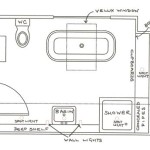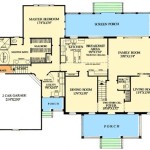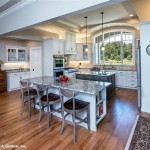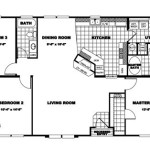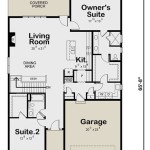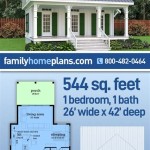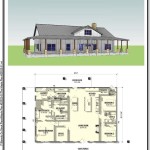Floor Plans With Inlaw Apartment: Multi-Generational Living Solutions
The increasing trend of multi-generational households has fueled a demand for homes designed with in-law apartments, also known as accessory dwelling units (ADUs). These self-contained living spaces, often attached to or detached from the main house, offer families the opportunity to live close together while maintaining a degree of independence and privacy. Thoughtful floor plans are crucial for creating a functional and comfortable living environment for both the primary residents and the occupants of the in-law apartment. This article will explore the key considerations and design elements involved in crafting effective floor plans with in-law apartments.
An in-law apartment is more than just an extra bedroom and bathroom. It's a fully functioning, independent living space that typically includes a bedroom, a bathroom, a living area, and a kitchen or kitchenette. The design should cater to the specific needs and lifestyle of its intended occupants, accounting for factors such as mobility, accessibility, and desired level of interaction with the main house. Careful planning ensures the in-law apartment feels like a comfortable and private home rather than simply an add-on.
Key Considerations for Designing In-Law Apartment Floor Plans
Several factors must be considered when developing a floor plan that incorporates an in-law apartment. These include the building codes and zoning regulations, the physical constraints of the property, the privacy needs of all occupants, and the overall budget for the project.
Zoning and Building Codes: Before any construction begins, it is essential to thoroughly research and comply with all local zoning ordinances and building codes pertaining to accessory dwelling units. Many municipalities have specific regulations regarding the size, setbacks, parking requirements, and permitted uses of ADUs. Failure to comply can result in costly fines and delays, or even the forced removal of the unit. Some jurisdictions may require a separate entrance, designated parking spaces, and adherence to accessibility standards. It is crucial to consult with local building officials and potentially a qualified architect or contractor familiar with ADU regulations in the area.
Privacy and Accessibility: Balancing the desire for family connection with the need for individual privacy is paramount. The floor plan should incorporate features that minimize noise transfer between the main house and the in-law apartment. This can be achieved through strategic placement of walls, the use of soundproofing materials, and separate entry points. The design should also consider the accessibility needs of the occupants. This may involve incorporating wider doorways, grab bars in bathrooms, and ramps or elevators to accommodate individuals with mobility challenges. Universal design principles, which focus on creating spaces that are usable by people of all ages and abilities, should be a guiding principle.
Layout and Functionality: The floor plan should maximize the use of space and create a functional and comfortable living environment. Open-concept designs can be effective for smaller in-law apartments, creating a sense of spaciousness and allowing for flexible furniture arrangements. Adequate storage space is also essential, as limited storage can lead to clutter and a feeling of confinement. The kitchen or kitchenette should be equipped with essential appliances, such as a refrigerator, stove or cooktop, and microwave. The bathroom should be designed for ease of use and accessibility, with considerations such as walk-in showers or accessible bathtubs.
Types of In-Law Apartment Floor Plans
In-law apartments can be integrated into a home in various ways, each with its own advantages and disadvantages. The choice of floor plan depends on the specific needs of the family, the characteristics of the property, and the budget for the project.
Attached In-Law Apartments: These are the most common type of in-law apartment. They are typically located on the ground floor of the main house, often with a separate entrance from the exterior. Attached apartments can also be incorporated into a basement or attic space, provided the space is properly finished and meets all building code requirements. A key advantage of attached apartments is their seamless integration with the main house, making it easier for family members to interact. However, it can also be more challenging to maintain privacy due to the shared walls and potential for noise transfer. A separate entrance is generally recommended to enhance the feeling of independence.
Detached In-Law Apartments: These are separate, self-contained structures located on the same property as the main house. They can be converted garages, backyard cottages, or newly constructed buildings. Detached apartments offer the highest level of privacy and independence for the occupants. They also provide greater flexibility in terms of design and layout, as they are not constrained by the existing structure of the main house. However, detached apartments can be more expensive to build due to the need for a separate foundation, utilities, and exterior walls. Zoning regulations may also be more restrictive for detached ADUs.
Above-Garage Apartments: These are apartments located above a detached or attached garage. They offer a compromise between the privacy of a detached apartment and the convenience of an attached apartment. Above-garage apartments typically have a separate entrance from the exterior, often via a staircase. They can be a cost-effective option if the garage already exists, as the foundation and roof are already in place. However, accessibility can be a challenge, as stairs may be difficult for individuals with mobility issues. Careful planning is needed to ensure adequate insulation and soundproofing to minimize noise transfer between the garage and the apartment.
Essential Design Elements for In-Law Apartment Floor Plans
Beyond the basic layout, several design elements contribute to the functionality and comfort of an in-law apartment. These elements encompass aspects such as lighting, ventilation, materials selection, and the integration of smart home technology.
Lighting and Ventilation: Adequate natural light and ventilation are crucial for creating a healthy and comfortable living environment. The floor plan should incorporate large windows and skylights to maximize natural light penetration. Cross-ventilation, achieved by placing windows on opposite walls, can help to circulate fresh air and reduce the need for air conditioning. Natural light not only enhances the aesthetic appeal of the apartment but also contributes to the overall well-being of the occupants. Proper ventilation helps to prevent the buildup of moisture and odors, creating a healthier indoor environment.
Materials and Finishes: The selection of materials and finishes should be durable, low-maintenance, and aesthetically pleasing. Durable flooring materials such as hardwood, laminate, or tile are ideal for high-traffic areas. Low-VOC paints and finishes should be used to minimize indoor air pollution. The color palette should be neutral and inviting, creating a sense of calm and relaxation. Consider using energy-efficient appliances and fixtures to reduce utility costs and minimize environmental impact. The materials used in the in-law apartment should complement the overall style of the main house, creating a cohesive look.
Smart Home Technology: Integrating smart home technology can enhance the convenience, security, and energy efficiency of the in-law apartment. Smart thermostats can be used to remotely control the temperature, reducing energy consumption. Smart lighting systems can be programmed to automatically turn on and off, improving security and saving energy. Security systems with remote monitoring capabilities can provide added peace of mind for both the occupants of the in-law apartment and the main house. Voice-controlled assistants can be used to operate various devices and appliances, providing added convenience and accessibility.
Designing a floor plan with an in-law apartment requires careful consideration of various factors, including zoning regulations, privacy needs, accessibility requirements, and the overall functionality of the space. By addressing these considerations thoughtfully and incorporating essential design elements, it is possible to create a comfortable, private, and functional living environment for multi-generational families.

Find The Perfect In Law Suite Our Best House Plans Dfd Blog

House Plan 65862 Tuscan Style With 2091 Sq Ft 3 Bed 2 Bath 1

Southern Style House Plan With In Law Suite

Country House Plan With 4 Bedrooms And 3 5 Baths 4427

House Plans With In Law Suites Houseplans Blog Com

House Plans With In Law Suites Houseplans Blog Com

Modern Farmhouse Plan With In Law Suite 70607mk Architectural Designs House Plans

Exquisite Mountain Modern Home Plan With In Law Suite And 4 Car Garage 95104rw Architectural Designs House Plans

One Story With In Law Suite Plan 2286

Cape Cod House Plans With Inlaw Suite Best Of Mother In New Multigenerational Country

